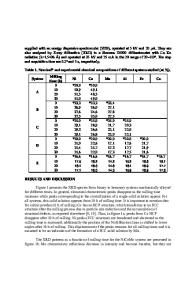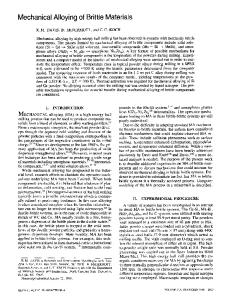Mechanical Alloying Behavior in the Nb-Si, Ta-Si, and Nb-Ta-Si Systems
- PDF / 347,691 Bytes
- 6 Pages / 420.48 x 639 pts Page_size
- 2 Downloads / 1,023 Views
MECHANICAL ALLOYING BEHAVIOR IN THE Nb-Si, K.S. Kumar and S.K. Mannan Martin Marietta Laboratories,
Ta-Si,
Baltimore, MD 21227,
AND Nb-Ta-Si SYSTEMS
USA
ABSTRACT The mechanical alloying behavior of elemental powders in the Nb-Si, The line Ta-Si, and Nb-Ta-Si systems was examined via X-ray diffraction. compounds NbSi 2 and TaSi form as crystalline compounds rather than amorphous products, but Nb 5 Si 3 and Ta Si?, although chemically analogous, The Ta 5 Si 3 composition respond very differently to mechanical milling. goes directly from elemental powders to an amorphous product, whereas The Nb Si 3 compound consists of Nb5 Si 3 forms as a crystalline compound. both the tetragonal room-temperature a phase (cca = 1.8) and the tetragonal Substituting increasing amounts of high-temperature R phase (c/a = 0.5). Ta for Nb in Nb 5 Si 3 initially stabilizes the a-Nb 5 Si 3 structure preferentially, and subsequently inhibits the formation of a crystalline compound.
INTRODUCTION In recent years, several workers have demonstrated that mechanical alloying (MA) of certain elemental powders can result in the formation of an amorphous structure with the same chemical composition as the powder mixture [1-4]. Based on limited studies, it appears that amorphous products corresponding to a specific composition can also be obtained by MA of mixtures of intermetallic compounds in the proper proportions [4]. These findings have been explained by thermodynamic arguments related to the free-energy difference between the amorphous phase and the mechanical mixture providing the driving force. In some cases, however, for reasons yet unexplained, MA of elemental powders has led to the formation of a compound [5,6]. In a recent paper [7], we showed that mechanical alloying behavior in group V transition metal/silicon systems was not uniform, and that amorphization was not the rule. A variety of paths was followed, depending on the metal-to-silicon ratio and the specific transition element (Nb, Ta, V) involved. The reasons for such behavior were not clear. Although the melting point, heat of formation, and crystal structures of Nb5Si 3 and Ta 5 Si 3 are similar, Nb5 Si 3 formed upon MA of the appropriate elemental powders was crystalline, whereas Ta 5 Si 3 was amorphous. However, MA of elemental blends of compositions corresponding to the respective disilicides, NbSi 2 and TaSi 2 , yielded crystalline compounds in both cases. In the work reported here, we continued the studies of MA behavior in the Nb-Si, Ta-Si, and Nb-Ta-Si systems to further our understanding of the operative mechanisms. Studies in the ternary system were limited to the pseudo-binary Nb5 Si 3 -Ta 5 Si 3 section. EXPERIMENTAL PROCEDURE Elemental powders < 44 um in size and with a nominal purity exceeding 99.5% by weight were blended in the necessary proportions to obtain selected compositions in the Nb-Si and Ta-Si binary systems. In the pseudo-binary Nb5 Si -Ta 5 Si 3 section, the Nb in Nb5 Si3 was systematically replaced by increasing amounts of Ta to yield compos itions
Data Loading...











